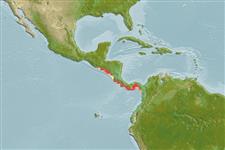Common names from other countries
>
Clupeiformes (Herrings) >
Engraulidae (Anchovies) > Engraulinae
Etymology: Lycengraulis: Greek, lykos = wolf + Greek, eggraulis, -eos = anchovy (Ref. 45335).
More on author: Kner.
Environment: milieu / climate zone / depth range / distribution range
Ekologi
marina; brackvatten; djupintervall 0 - 50 m (Ref. 189). Tropical; 14°N - 6°N, 91°W - 77°W (Ref. 189)
Eastern Central Pacific: El Salvador to Panama Bay and possibly northern Ecuador.
Size / Vikt / Age
Maturity: Lm ? range ? - ? cm
Max length : 20.5 cm SL hane/ej könsbestämd; (Ref. 189)
Short description
Bestämningsnycklar | Morfologi | Morfometri
Taggstrålar i ryggfenan (totalt) : 0; Taggstrålar i analfenan: 0; Mjukstrålar i analfenan: 21 - 24. Snout about 2/3 eye diameter; maxilla moderate, tip somewhat bluntly rounded, reaching almost to sub-operculum, teeth becoming larger after first third of jaw. Lower gill rakers fairly short, none rudimentary. Dorsal fin origin behind midpoint of body; anal fin origin under anterior third of dorsal fin base. Silver stripe lost in larger fishes; a curve of black dots on operculum .
Occurs inshore but entering brackish if not fresh water (thus probably similar to L. grossidens). Feeds on fishes (including other anchovies), perhaps also crustaceans. Nearly ripe females occurred in the Gulf of Nicoya, Costa Rica in June, August and September, and juveniles of 3.3-4.5 cm in January and October. TL = 1.257 SL.
Life cycle and mating behavior
Maturities | Reproduktion | Spawnings | Egg(s) | Fecundities | Larver
Nearly ripe females occurred in the Gulf of Nicoya, Costa Rica in June, August and September, and juveniles of 3.3 to 4.5 cm in January and October.
Whitehead, P.J.P., G.J. Nelson and T. Wongratana, 1988. FAO Species Catalogue. Vol. 7. Clupeoid fishes of the world (Suborder Clupeoidei). An annotated and illustrated catalogue of the herrings, sardines, pilchards, sprats, shads, anchovies and wolf-herrings. FAO Fish. Synop. 125(7/2):305-579. Rome: FAO. (Ref. 189)
IUCN Red List Status (Ref. 130435)
CITES (Ref. 128078)
Not Evaluated
Threat to humans
Harmless
Human uses
Fiskeri: husbehovsfiske
Verktyg
Special reports
Download XML
Internet-källor
Estimates based on models
Preferred temperature (Ref.
115969): 24.4 - 28.6, mean 27.8 (based on 16 cells).
Phylogenetic diversity index (Ref.
82804): PD
50 = 0.5312 [Uniqueness, from 0.5 = low to 2.0 = high].
Bayesian length-weight: a=0.00537 (0.00253 - 0.01141), b=3.13 (2.96 - 3.30), in cm Total Length, based on LWR estimates for this (Sub)family-body shape (Ref.
93245).
Trofisk nivå (Ref.
69278): 4.2 ±0.73 se; based on food items.
Resiliens (Ref.
120179): Hög, lägsta populationsfördubblingstid mindre än 15 månader (Preliminary K or Fecundity.).
Fishing Vulnerability (Ref.
59153): Low vulnerability (15 of 100).
